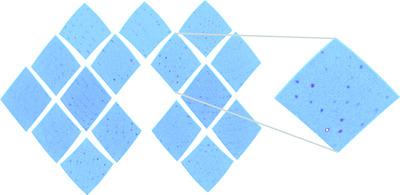当前位置:
X-MOL 学术
›
Acta Cryst. D
›
论文详情
Our official English website, www.x-mol.net, welcomes your feedback! (Note: you will need to create a separate account there.)
Towards cryogenic neutron crystallography on the reduced form of [NiFe]‐hydrogenase
Acta Crystallographica Section D ( IF 2.2 ) Pub Date : 2020-10-08 , DOI: 10.1107/s2059798320011365 Takeshi Hiromoto 1 , Koji Nishikawa 2 , Seiya Inoue 2 , Hiroaki Matsuura 2 , Yu Hirano 1 , Kazuo Kurihara 1 , Katsuhiro Kusaka 3 , Matthew Cuneo 4 , Leighton Coates 4 , Taro Tamada 1 , Yoshiki Higuchi 2
Acta Crystallographica Section D ( IF 2.2 ) Pub Date : 2020-10-08 , DOI: 10.1107/s2059798320011365 Takeshi Hiromoto 1 , Koji Nishikawa 2 , Seiya Inoue 2 , Hiroaki Matsuura 2 , Yu Hirano 1 , Kazuo Kurihara 1 , Katsuhiro Kusaka 3 , Matthew Cuneo 4 , Leighton Coates 4 , Taro Tamada 1 , Yoshiki Higuchi 2
Affiliation

|
A membrane‐bound hydrogenase from Desulfovibrio vulgaris Miyazaki F is a metalloenzyme that contains a binuclear Ni–Fe complex in its active site and mainly catalyzes the oxidation of molecular hydrogen to generate a proton gradient in the bacterium. The active‐site Ni–Fe complex of the aerobically purified enzyme shows its inactive oxidized form, which can be reactivated through reduction by hydrogen. Here, in order to understand how the oxidized form is reactivated by hydrogen and further to directly evaluate the bridging of a hydride ligand in the reduced form of the Ni–Fe complex, a neutron structure determination was undertaken on single crystals grown in a hydrogen atmosphere. Cryogenic crystallography is being introduced into the neutron diffraction research field as it enables the trapping of short‐lived intermediates and the collection of diffraction data to higher resolution. To optimize the cooling of large crystals under anaerobic conditions, the effects on crystal quality were evaluated by X‐rays using two typical methods, the use of a cold nitrogen‐gas stream and plunge‐cooling into liquid nitrogen, and the former was found to be more effective in cooling the crystals uniformly than the latter. Neutron diffraction data for the reactivated enzyme were collected at the Japan Photon Accelerator Research Complex under cryogenic conditions, where the crystal diffracted to a resolution of 2.0 Å. A neutron diffraction experiment on the reduced form was carried out at Oak Ridge National Laboratory under cryogenic conditions and showed diffraction peaks to a resolution of 2.4 Å.
中文翻译:

还原[NiFe]-氢化酶形式的低温中子晶体学
寻常脱硫弧菌的膜结合氢化酶宫崎骏F是一种金属酶,在其活性位点包含双核Ni-Fe络合物,主要催化分子氢的氧化以在细菌中产生质子梯度。需氧纯化酶的活性位镍铁复合物表现出其非活性氧化形式,可以通过氢还原而重新活化。在这里,为了了解氧化形式如何被氢重新活化并进一步评估镍-铁配合物的还原形式中氢化物配体的桥连,对在氢气氛中生长的单晶进行了中子结构测定。低温晶体学正被引入中子衍射研究领域,因为它可以捕获短寿命的中间体并以更高的分辨率收集衍射数据。为了优化在厌氧条件下大晶体的冷却,使用两种典型的方法通过X射线评估了对晶体质量的影响,这两种方法是使用冷氮气流并将其急冷到液氮中,发现前者可以比后者更有效地均匀冷却晶体。重新活化的酶的中子衍射数据是在低温条件下在日本光子加速器研究中心收集的,其中晶体衍射至2.0Å的分辨率。在低温条件下,在橡树岭国家实验室进行了还原形式的中子衍射实验,结果表明衍射峰的分辨率为2.4。使用冷氮气流并将其骤冷为液氮,发现前者比后者更有效地均匀冷却晶体。重新活化的酶的中子衍射数据是在低温条件下在日本光子加速器研究中心收集的,其中晶体衍射至2.0Å的分辨率。在低温条件下,在橡树岭国家实验室进行了还原形式的中子衍射实验,结果表明衍射峰的分辨率为2.4。使用冷氮气流并将其骤冷为液氮,发现前者比后者更有效地均匀冷却晶体。重新活化的酶的中子衍射数据是在低温条件下在日本光子加速器研究中心收集的,其中晶体衍射至2.0Å的分辨率。在低温条件下,在橡树岭国家实验室进行了还原形式的中子衍射实验,结果表明衍射峰的分辨率为2.4。重新活化的酶的中子衍射数据是在低温条件下在日本光子加速器研究中心收集的,其中晶体衍射至2.0Å的分辨率。在低温条件下,在橡树岭国家实验室进行了还原形式的中子衍射实验,结果表明衍射峰的分辨率为2.4。重新活化的酶的中子衍射数据是在低温条件下在日本光子加速器研究中心收集的,其中晶体衍射至2.0Å的分辨率。在低温条件下,在橡树岭国家实验室进行了还原形式的中子衍射实验,结果表明衍射峰的分辨率为2.4。
更新日期:2020-10-08
中文翻译:

还原[NiFe]-氢化酶形式的低温中子晶体学
寻常脱硫弧菌的膜结合氢化酶宫崎骏F是一种金属酶,在其活性位点包含双核Ni-Fe络合物,主要催化分子氢的氧化以在细菌中产生质子梯度。需氧纯化酶的活性位镍铁复合物表现出其非活性氧化形式,可以通过氢还原而重新活化。在这里,为了了解氧化形式如何被氢重新活化并进一步评估镍-铁配合物的还原形式中氢化物配体的桥连,对在氢气氛中生长的单晶进行了中子结构测定。低温晶体学正被引入中子衍射研究领域,因为它可以捕获短寿命的中间体并以更高的分辨率收集衍射数据。为了优化在厌氧条件下大晶体的冷却,使用两种典型的方法通过X射线评估了对晶体质量的影响,这两种方法是使用冷氮气流并将其急冷到液氮中,发现前者可以比后者更有效地均匀冷却晶体。重新活化的酶的中子衍射数据是在低温条件下在日本光子加速器研究中心收集的,其中晶体衍射至2.0Å的分辨率。在低温条件下,在橡树岭国家实验室进行了还原形式的中子衍射实验,结果表明衍射峰的分辨率为2.4。使用冷氮气流并将其骤冷为液氮,发现前者比后者更有效地均匀冷却晶体。重新活化的酶的中子衍射数据是在低温条件下在日本光子加速器研究中心收集的,其中晶体衍射至2.0Å的分辨率。在低温条件下,在橡树岭国家实验室进行了还原形式的中子衍射实验,结果表明衍射峰的分辨率为2.4。使用冷氮气流并将其骤冷为液氮,发现前者比后者更有效地均匀冷却晶体。重新活化的酶的中子衍射数据是在低温条件下在日本光子加速器研究中心收集的,其中晶体衍射至2.0Å的分辨率。在低温条件下,在橡树岭国家实验室进行了还原形式的中子衍射实验,结果表明衍射峰的分辨率为2.4。重新活化的酶的中子衍射数据是在低温条件下在日本光子加速器研究中心收集的,其中晶体衍射至2.0Å的分辨率。在低温条件下,在橡树岭国家实验室进行了还原形式的中子衍射实验,结果表明衍射峰的分辨率为2.4。重新活化的酶的中子衍射数据是在低温条件下在日本光子加速器研究中心收集的,其中晶体衍射至2.0Å的分辨率。在低温条件下,在橡树岭国家实验室进行了还原形式的中子衍射实验,结果表明衍射峰的分辨率为2.4。



























 京公网安备 11010802027423号
京公网安备 11010802027423号